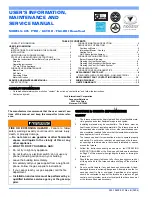
9
Drain Trap and Lines
In horizontal applications, the condensate drain trap is secured to
the furnace side panel, suspending it below the furnace. A
minimum clearance of 4
³⁄₄
" (12.1 cm) below the furnace must be
provided for the drain trap. Additionally, the appropriate
downward piping slope must be maintained from the drain trap to
the drain location. Refer to “Condensate Drain Trap and Lines”
for further details. If the drain trap and drain line will be exposed
to temperatures near or below freezing, adequate measures must
be taken to avoid condensate from freezing.
Leveling
Leveling ensures proper condensate drainage from the heat
exchanger and induced draft blower. For proper flue pipe
drainage, the furnace must be level lengthwise from end to end.
The furnace should also be level from back to front, or have a
slight tilt with the access doors sloping downward
³⁄₄
" (1.9 cm)
lower than the back panel. The slight tilt allows the heat
exchanger condensate, generated in the recuperator coil, to flow
forward to the recuperator coil front cover.
Alternate Vent/Flue Connections
In horizontal installations, provisions for alternate flue and
combustion air piping are available for upflow furnaces with left
discharge and counterflow furnaces with right air discharge. This
configuration allows the flue and combustion air piping to be run
vertically through the side of the furnace. Refer to the
“Recommended Installation Positions” illustrations for further
details. The standard piping connections may also be used in
these positions. See “Vent/Flue Pipe and Combustion Air Pipe”
for details concerning the conversion to the alternate vent/flue
and combustion air connections.
When using the horizontal alternate vent configuration, you must
use the RF000142 vent drain kit. See “Alternate Flue/Vent
Location” illustration.
NOTE: Alternate vertical piping connections cannot be used
when an upflow furnace is installed with the supply air
discharging to the right, or when a counterflow furnace is
installed with the supply air discharging to the left. In either case,
use the standard flue and combustion air piping connections.
Alternate Flue/Vent Location
NOTES:
■
The field supplied drain hose is connected from the vent/
drain connection to the condensate drain line with a field
supplied connector.
■
Make a small loop in the drain hose to serve as a P-trap.
Recommended Installation Positions—Upright Upflow
Recommended Installation Positions—Horizontal
Upflow—Left Side Panel Discharge
Recommended Installation Positions—Horizontal
Upflow—Right Side Panel Discharge
Alternate Electrical and Gas Line Connections
This furnace has provisions allowing for electrical and gas line
connections through either side panel. In horizontal applications,
the connections can be made either through the top or bottom of
the furnace.
Drain Pan
A drain pan must be provided if the furnace is installed above a
conditioned area. The drain pan must cover the entire area under
the furnace (and air conditioning coil, if applicable).
Freeze Protection
Refer to “Horizontal Applications and Conditions—Drain Trap and Lines.”
Furnace Suspension
If the furnace is installed in a crawl space, it must be suspended from
the floor joist or supported by a concrete pad.
NOTE: Never install the furnace on the ground or allow it to be
exposed to water.
Refer to “Location Requirements and Considerations—Furnace
Suspension” for further details.
A. Vent/Drain
B. Airflow
C. Field supplied drain hose
A
B
C
A. Air discharge
B. Alternate flue pipe location
C. Side return duct connections
D. Bottom return duct connection
A. Air discharge
B. Alternate flue pipe location
C. Bottom return duct connection
A. Bottom return duct connection
B. Air discharge
A
B
C
C
D
A
B
C
A
B










































